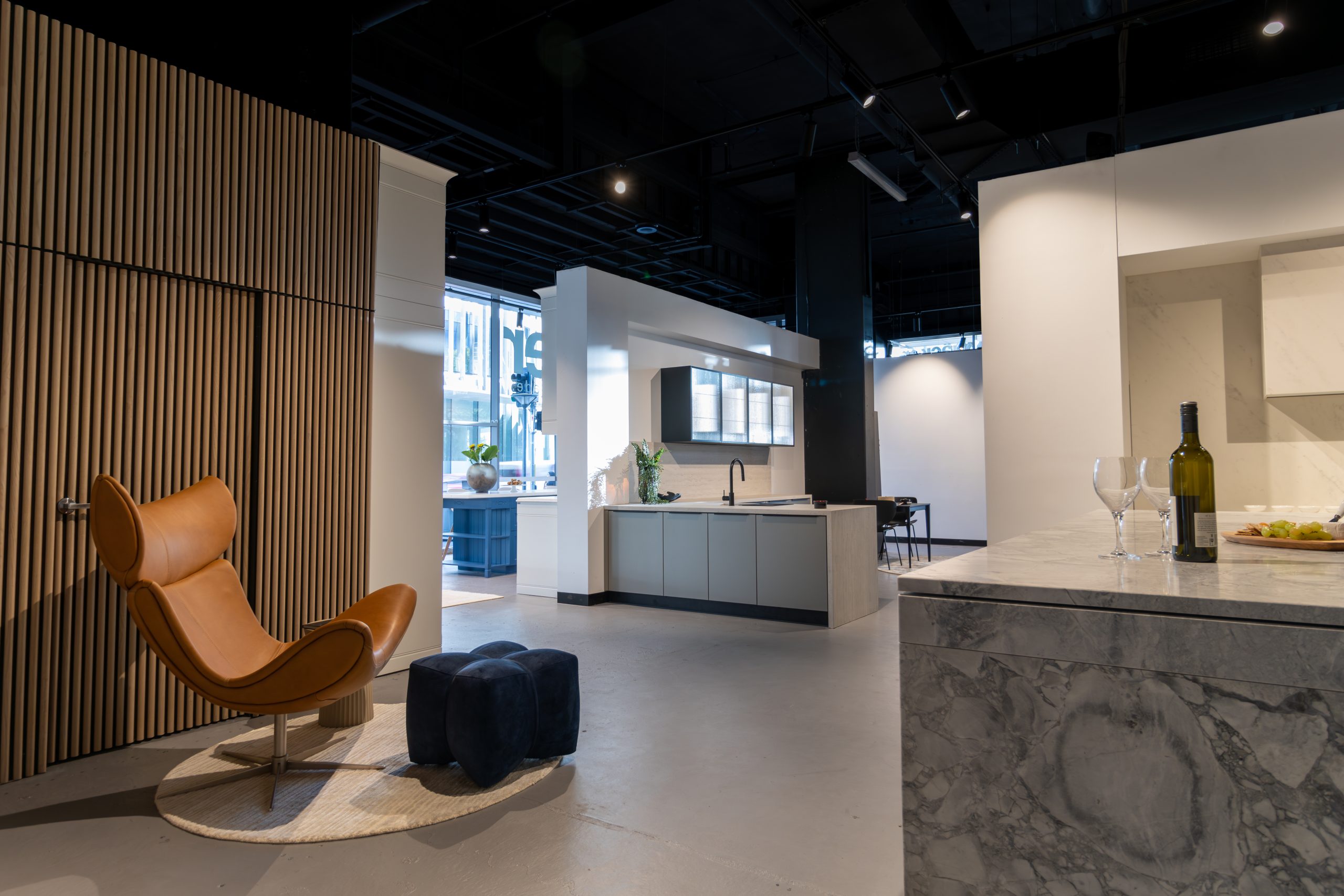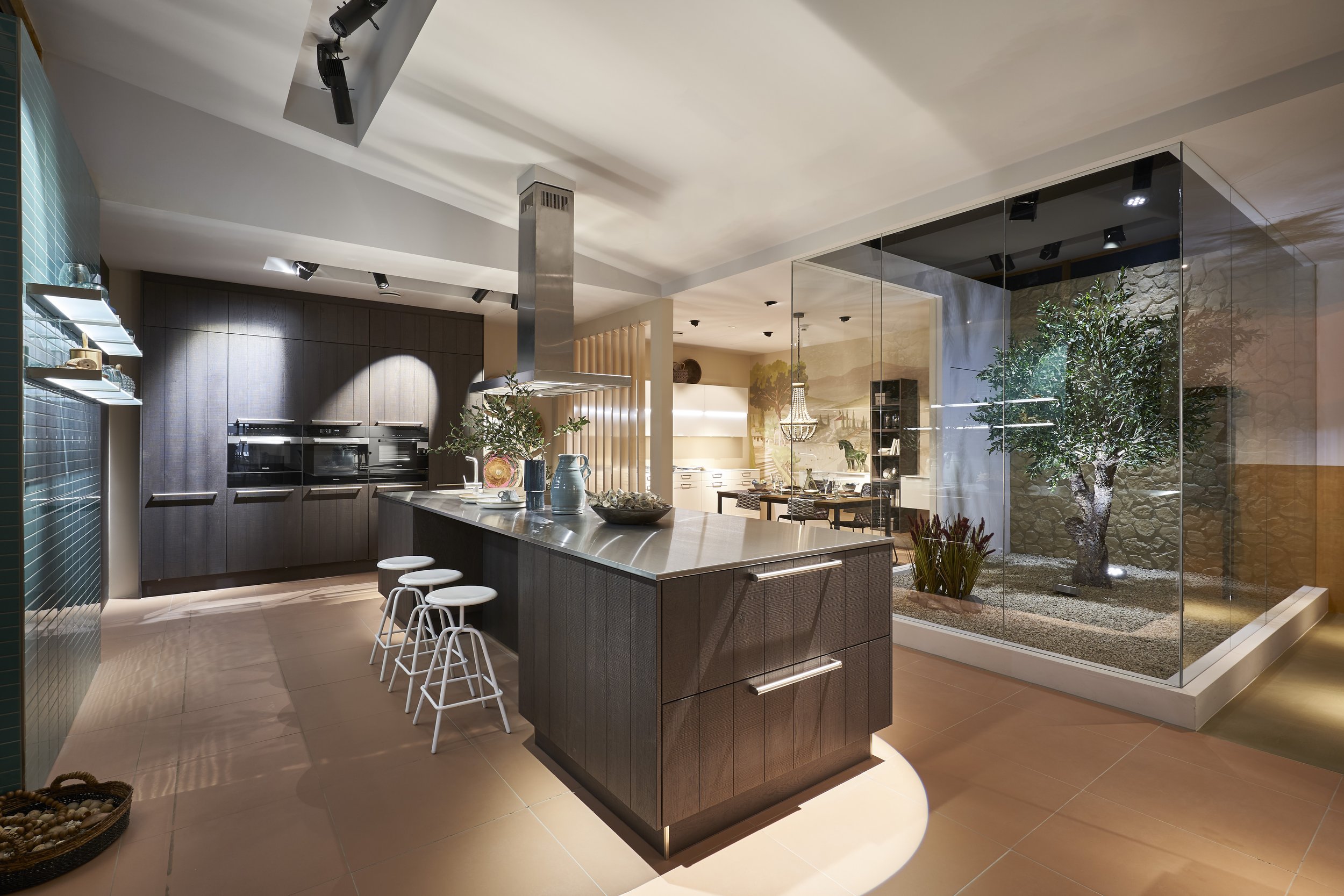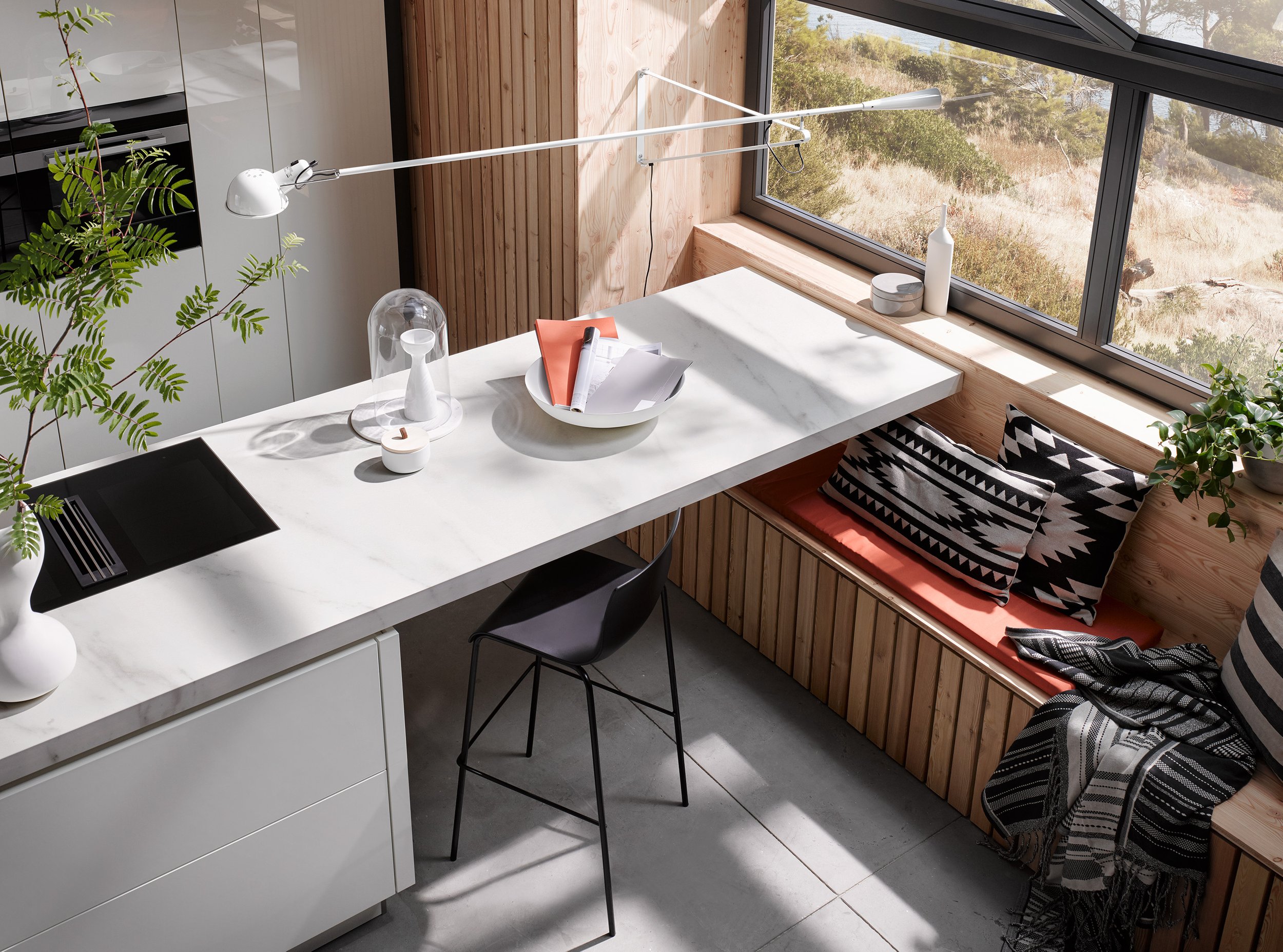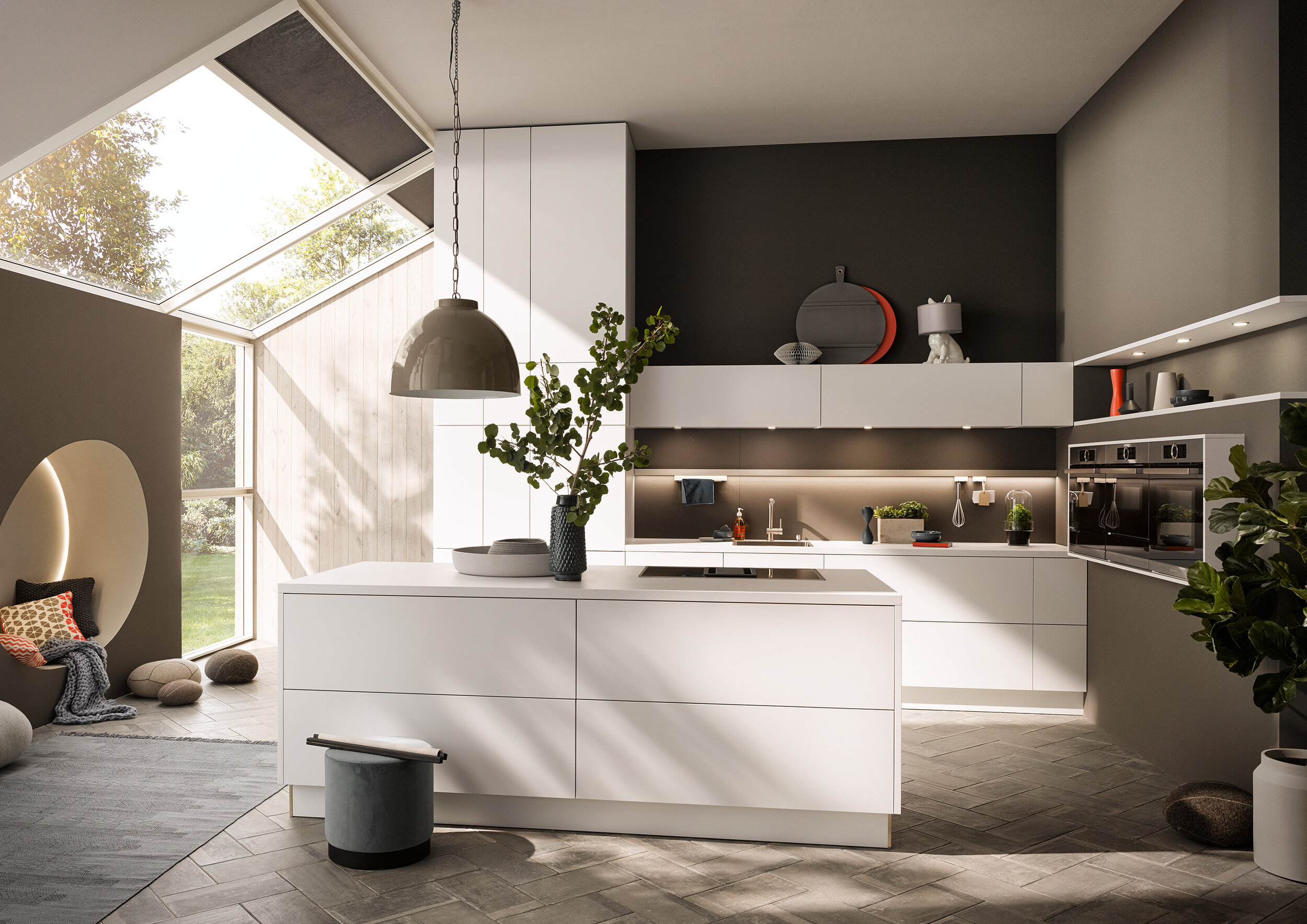
G-Shaped Kitchens: Design, Benefits, and Layout Ideas
The G-shaped kitchen has become increasingly popular in Australian homes, offering a smart evolution of the classic U-shaped layout. By adding a peninsula to three walls of cabinetry, this design creates exceptional functionality while maintaining an open feel. Whether you’re renovating or building new, understanding this versatile layout could transform how you think about kitchen design.
What is a G-shaped kitchen?
A G-shaped kitchen layout combines the efficiency of a U-shaped kitchen with the added functionality of a peninsula. Picture three walls of continuous benchtops and cabinets, then add a fourth partial wall that extends into the space, that’s your “G” formation.
The peninsula isn’t just decorative. It serves multiple purposes:
- Extra preparation space during busy cooking sessions
- A casual breakfast bar for quick meals
- Natural room divider that maintains flow between areas
- Housing for appliances like cooktops or additional sinks
This G kitchen layout originated from the need to maximise both storage and workspace whilst keeping everything within easy reach. The design naturally creates work zones – perhaps food prep happens on one wall, cooking on another, and cleaning on the third, with the peninsula serving as command central.
Modern G-shaped kitchen design has evolved far beyond purely functional considerations. Today’s versions incorporate beautiful materials, smart storage solutions, and clever lighting that prevents any feeling of being boxed in.
Advantages and Disadvantages of a Kitchen G-Shape Layout
Advantages
Space Utilisation Excellence The layout provides maximum bench space and storage within its footprint, making every square centimetre work harder. The peninsula adds significant preparation area without requiring the clearance space that a full island demands. This configuration creates natural work zones, allowing multiple family members to use the kitchen simultaneously without getting in each other’s way.
Superior Workflow G-shaped kitchen design ideas consistently emphasise how this layout supports efficient cooking patterns. The continuous benchtop flow allows seamless movement between different tasks, whilst the peninsula provides an additional work surface accessible from multiple angles. Benefits include:
- Several work triangles rather than just one
- Seamless movement between prep, cooking, and cleaning
- Peninsula accessible from multiple points in the kitchen
- Reduced steps during meal preparation
Exceptional Storage Capacity With cabinetry available along all walls plus the peninsula, storage opportunities abound. This includes valuable corner storage that modern hardware solutions make highly accessible. Floor-to-ceiling options along multiple walls maximise vertical space without consuming additional floor area.
Disadvantages
While G-shaped kitchens offer many benefits, they’re not perfect for every home:
- Can feel enclosed in smaller spaces if not carefully planned
- Peninsula may obstruct traffic flow during busy periods
- Higher costs due to extensive cabinetry and benchtop requirements
- Corner areas require quality hardware for easy access
- Lighting challenges from enclosed design creating shadows
- Risk of overwhelming storage leading to clutter
G-Shaped Kitchen Layout Ideas
Efficient Use of Peninsula Space
Transform your peninsula into a multi-functional workspace that serves different needs throughout the day. During meal preparation, it provides extra bench space for ingredients and equipment. When entertaining, it becomes a natural serving station where guests can gather.
Peninsula Sizing Guidelines:
- Keep approximately 1.2 metres wide for optimal function
- Maintain good traffic flow around the kitchen
- Provide ample workspace without creating bottlenecks
- Allow comfortable seating if including bar stools
Storage integration makes the peninsula even more valuable. Upper cabinets house dishes and glassware for easy entertaining access, whilst lower cabinets accommodate small appliances or cookware. Open shelving at the peninsula’s end displays attractive items whilst maintaining visual lightness.
Strategic Appliance Placement
Creating an efficient work triangle remains crucial in small G-shaped kitchen layout planning. Position your sink on one wall to take advantage of natural light and plumbing efficiency, with the cooktop and refrigerator distributed between the remaining walls and peninsula.
| Appliance | Ideal Position | Benefits |
| Sink | Centre wall, under window | Natural light, garden views |
| Cooktop | Side wall or peninsula | Accessible, good ventilation |
| Refrigerator | End of peninsula or side wall | Easy access, doesn’t block flow |
| Dishwasher | Adjacent to sink | Logical workflow |
Space-Saving Appliance Tips:
- Counter-depth refrigerators maintain streamlined sight lines
- Built-in ovens free valuable bench space
- Microwave drawers integrate seamlessly
- Compact dishwashers suit smaller layouts perfectly
Maximising Vertical Storage
Floor-to-ceiling cabinetry transforms vertical space into valuable storage without consuming additional floor area. Install these dramatic storage walls opposite the peninsula to create visual balance whilst housing everything from everyday dishes to occasional entertaining pieces.
Corner solutions deserve special attention in G-shaped kitchen designs. Modern storage options include:
- Lazy Susan units for easy rotating access
- Pull-out corner drawers that extend fully
- Magic corner systems maximising awkward spaces
- Diagonal corner cabinets with specialised hardware
Balance closed storage with strategic open shelving to prevent the space from feeling too enclosed. Display beautiful dishes or cookbooks on open shelves whilst keeping everyday clutter hidden behind closed doors.
Light and Colour to Open Space
Light colours become your best friend in managing the enclosed feeling that sometimes accompanies G-shaped layouts. Whites, pale greys, and soft pastels reflect available light throughout the space whilst creating visual continuity that makes everything feel more spacious.
Colour Strategy for G-Shaped Kitchens:
- Use consistent light tones on walls and main cabinetry
- Consider two-tone approach with darker bases, lighter uppers
- Utilise the peninsula for subtle colour contrast
- Choose reflective finishes for splashbacks and benchtops
Lighting requires multiple layers to work effectively. Under-cabinet LED strips eliminate shadows on work surfaces whilst recessed ceiling lights provide general illumination. Pendant lights over the peninsula create beautiful focal points whilst providing task lighting for food preparation or casual dining.
Multi-Functional Storage Solutions
Hidden storage opportunities abound in G-shaped kitchens. Toe-kick drawers under base cabinets accommodate flat items like baking sheets, whilst space beneath the peninsula overhang houses everything from cookbooks to charging stations.
Smart Storage Ideas:
- Pull-out pantry systems in deeper cabinets
- Appliance garages for clutter-free benchtops
- Vertical dividers for baking trays and cutting boards
- Soft-close mechanisms on all drawers and doors
These mechanisms bring items from back to front effortlessly, ensuring nothing gets forgotten in kitchen depths. Quality hardware enhances daily functionality whilst contributing to the kitchen’s long-term durability.
Visual and Textural Contrast
Introduce personality through carefully chosen materials and finishes that prevent the kitchen from feeling monotonous. Natural wood elements bring warmth to otherwise streamlined designs, whilst stone textures on benchtops add sophisticated depth.
The peninsula offers an excellent opportunity for design emphasis:
- Contrasting benchtop materials create focal points
- Different cabinet finishes add visual interest
- Waterfall edges provide contemporary appeal
- Interesting architectural details enhance character
Keep patterns appropriately scaled – what works in a large kitchen might feel overwhelming in a compact one.
Creating a Social Hub
Design the peninsula to encourage family interaction and casual dining. Comfortable seating with adequate knee room transforms this workspace into a gathering spot where family members naturally congregate.
Peninsula Seating Considerations:
- Choose swivel stools for flexibility
- Ensure 600mm knee clearance minimum
- Position pendant lighting for ambience
- Include power points for device charging
Maintain sight lines to nearby spaces by avoiding upper cabinets on the room-facing side of the peninsula. This keeps the kitchen feeling connected to the broader home whilst maintaining its defined workspace character.
Practical Finishing Touches
Hardware selection impacts both function and aesthetics. Choose quality mechanisms that operate smoothly under daily use whilst contributing to the kitchen’s overall design aesthetic.
Surface Selection Guide:
| Surface | Recommended Materials | Key Benefits |
| Benchtops | Quartz, porcelain, natural stone | Durability, low maintenance |
| Splashback | Glass, ceramic, natural stone | Easy cleaning, light reflection |
| Cabinetry | Quality timber, thermoformed surfaces | Longevity, design flexibility |
Quality tapware serves as both functional necessity and design statement. Choose pieces that complement your overall aesthetic whilst providing the performance needed for busy kitchen use.
Small vs. Large G-Shaped Kitchen: Which Layout Suits Your Home?
Small G-Shaped Kitchens Work best when efficiency and storage maximisation take priority over expansive entertaining areas. These compact versions excel in apartments or smaller homes where every centimetre counts.
Key considerations for smaller spaces:
- Light colours prevent cramped feelings
- Compact appliances save precious space
- Smart storage solutions become essential
- Strategic lighting prevents tunnel effects
Large G-Shaped Kitchens Accommodate generous proportions that suit families who cook frequently and entertain regularly. These layouts can include larger appliances, more generous peninsula dimensions, and dramatic design elements.
Benefits of larger G-shaped layouts:
- Multiple work zones for different activities
- Room for premium appliances and features
- Generous peninsula for extensive seating
- Space for dramatic design statements
The key lies in understanding your cooking habits, family size, and lifestyle preferences. A well-designed small G-shaped kitchen often functions better than a poorly planned large one, proving that thoughtful design matters more than square footage.







